This post may contain affiliate links. Please read our disclosure policy.
This recipe for gluten free buns is for everyone who has ever eaten a burger on a lettuce wrap and pretended it was “fine.” I love lettuce as much as the next person, but it's not a hamburger bun.

Table of Contents
The no bun burger should be a choice
Whether there's a gluten free bun available or not, I usually go for a lettuce wrap. If that makes no sense to you considering how I've been complaining about the bun-less gluten free burger since 2011, allow me to explain.
If I'm eating a burger, whether it's vegetarian or meat, I just don't care for it with any sort of bread in every bite. I've been like that for as long as I can remember, long before I even knew what gluten was. But that is my choice.
My gluten free son likes a bun, and he should have one. There are more and more fast-casual hamburger restaurants that can accommodate gluten free eaters, which is great. But many of them can only offer you a lettuce wrap. I love lettuce wraps, but I prefer to choose among alternatives.
What makes this the best gluten free buns recipe
This gluten free bun recipe is very simple, and accommodates other dietary restrictions quite easily. The dough can be made up to 3 days ahead of time, and the baked rolls freeze really well.
And when I say that these are the best gluten free hamburger buns, I mean it! But not just for hamburgers. Depending on how you shape the dough, you can make smaller sliders, fatter rolls, or flatter sandwich buns.
When it comes to taste and texture, you really won't be disappointed. This isn't a fragile, crumbly roll that's going to fall apart when you bite into a big, juicy gluten free hamburger or pile it high with lunch meat, lettuce, and all the fixings.
This gluten free bread is soft and squishy and everything you've ever wanted in gf hamburger buns.
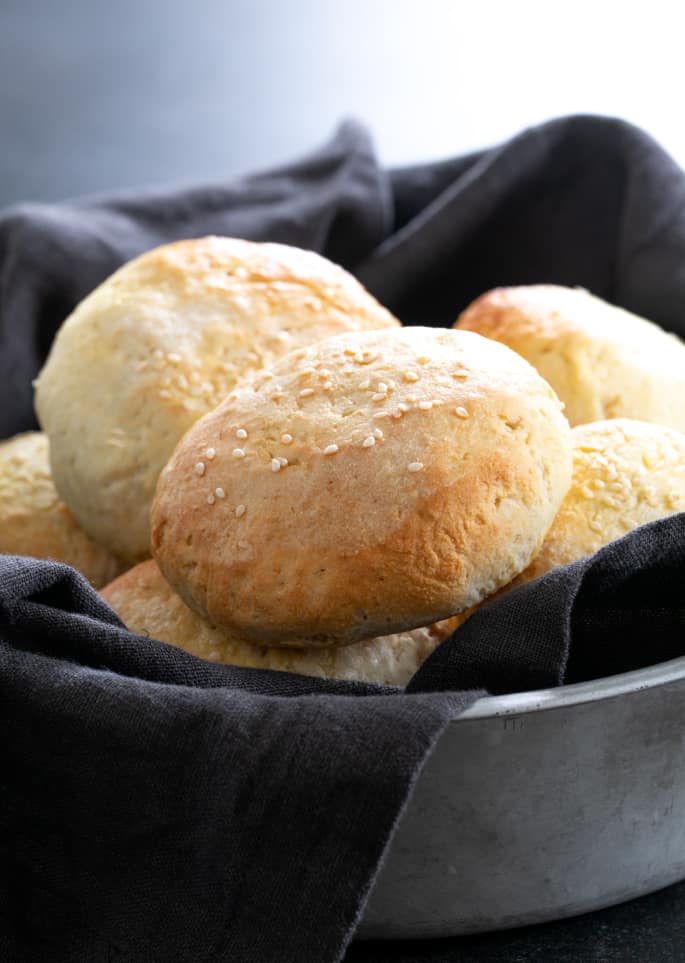
Gluten free buns ingredient notes
- All purpose gluten free flour blend – I highly recommend Better Batter for these hamburger buns, as it's by far the best all purpose gluten free flour to use as a base in yeast bread. You can also combine an all purpose blend + Expandex (see recipe notes for more info).
- Xanthan gum – only include it if your gf flour blend doesn't already contain it (Better Batter, for example, already has xanthan gum)
- Buttermilk blend powder – helps produce a tender bread, all while adding some flavor; see the substitutions list for a dairy free option. Do not use liquid buttermilk in its place, as your dough will be soupy.
- Yeast – you can use active dry yeast if you want, but instant yeast is easier. If you decide to use active dry yeast, you'll need 25% more yeast, by weight, and you'll have to hydrate it first in some of the water from the recipe.
- Apple cider vinegar – helps with lift, tenderizes the bread dough, and adds subtle flavor
- Cream of tartar, and baking soda – also helps with lift for an airy bread, and neutralize the acidic ingredients
- Light brown sugar – will feed your yeast, and add some depth of flavor
- Salt – Salt adds flavor to your bread; bread without salt is inedible!
- Butter – you want room temperature, not melted butter; otherwise the dough won't set up properly
- Eggs – an egg white helps bind the bread and make it fluffy, and while a whole egg gets beaten to use as an egg wash
- Warm water – temperature is important here; if the water's too hot, you'll kill your yeast
- Sesame seeds – poppy seeds, onion flakes, dried herbs — you've got options for topping your bread, if you wish to
Tips for making gluten free hamburger buns
Similar to our gluten free bread recipe for sandwiches , the dough for these buns is made mostly by dumping all of the ingredients (first dry, then wet) in a large bowl, and then mixing until fluffy.
Other than having the right recipe, of course, and the right, quality gluten free ingredients, there are some keys to the success of this recipe. Let's talk about them.
Bring your gluten free hamburger bun ingredients to room temp
Mixing some ingredients, like butter, just goes easier when they're softer.
But more than that, you need to create the ideal environment to activate your yeast for this burger buns recipe.
As yeast needs warmth to get going (which you'll kick start with the warm water), you'll only put the brakes on if you toss in cold butter and eggs.
Don't be afraid of a wet dough
If you want any yeasted dough to rise, you must have a proper wet to dry ingredient ratio. When the ratio of wet to dry ingredients is too low, the dry ingredients (most the flour) are overwhelming the wet ingredients (mostly the water), and the yeast will not rise. That's just the way it works.
Yeast isn't active at very, very high temperatures or very, very low temperatures, but it's rare that temperature will prevent your dough from rising. Those toxic temperatures are very extreme.
If your dough isn't rising, it's usually because your dough is too dry—or you didn't wait long enough.
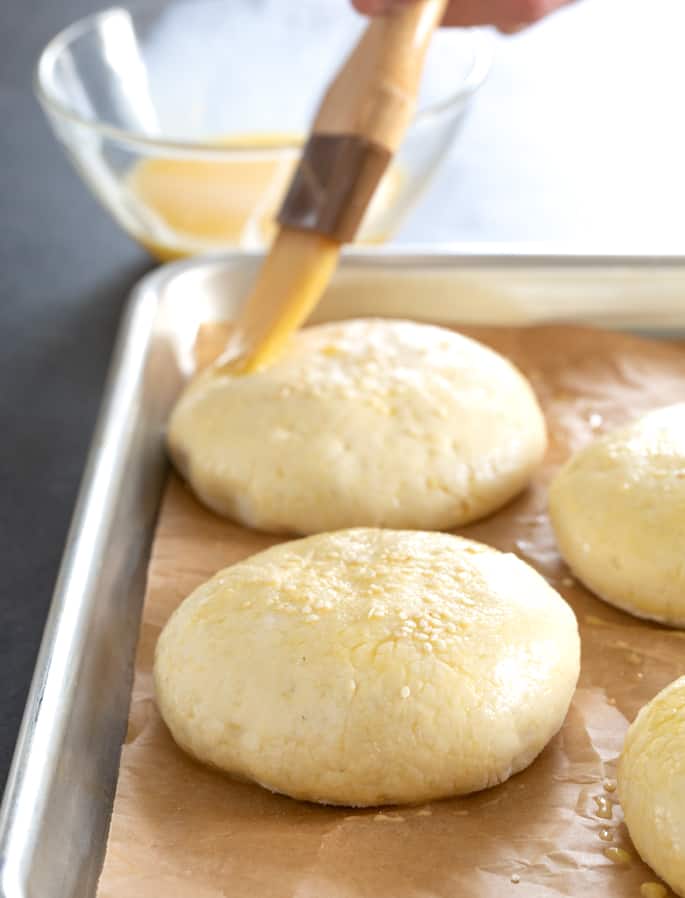
Shape with a light touch
In this sort of recipe, I prefer to start with a wet dough. It's more difficult to shape and handle, but you can flour the dough generously during shaping without drying it out too much.
Just handle the dough with a light touch, and even a bit of extra flour won't incorporate into the center of the dough where it will stifle the yeast.
Be patient but don't let it rise too much
If your dough hasn't risen enough after shaping, your kitchen might be rather dry or a bit on the chilly side. Don't worry—if you've measured your ingredients properly (including weighing the water so you didn't undermeasure it) and you've covered the baking sheet properly, the dough will rise.
If the environment isn't quite right, it will just slow the yeast's activity. Be patient with the rise.
Since this recipe is made in the batter-style (like our beloved white sandwich bread), it doesn't rise as smoothly as the recipes made with gluten free bread flour. When conventional bread rises, the gluten creates an invisible netting that traps the rise and keeps the top of the bread taut, like when you pull plastic wrap tightly over a bowl.
Without the gluten or even a super close replacement, in a recipe like this, the top of the dough will become pitted and cratered at the very end of a proper rise. When the craters begin to form, the dough has risen fully and it's ready for the egg wash and a spin in a hot oven.
Storing gluten free burger buns
You can keep your gf buns at room temperature on the kitchen counter for about three days. Just keep them in an airtight container or zip-top bag so that they don't dry out.
If you're making a big batch of gluten free hamburger buns to store for later, give them time to cool completely, slice them, and then wrap them individually. For extra protection from freezer burn, throw a few wrapped buns into a zip-top bag, and then pop them in the freezer.
Burger buns stay good on ice for about two months. To defrost, remove what you need and leave them in the refrigerator overnight. You can also drop them into a toaster oven while frozen, on the light setting.
The texture of the bread will change a bit from being frozen, but you can improve it by toasting the bread with a little bit of butter in a skillet. You can also wrap a bun in a damp paper towel and microwave for 20 seconds.
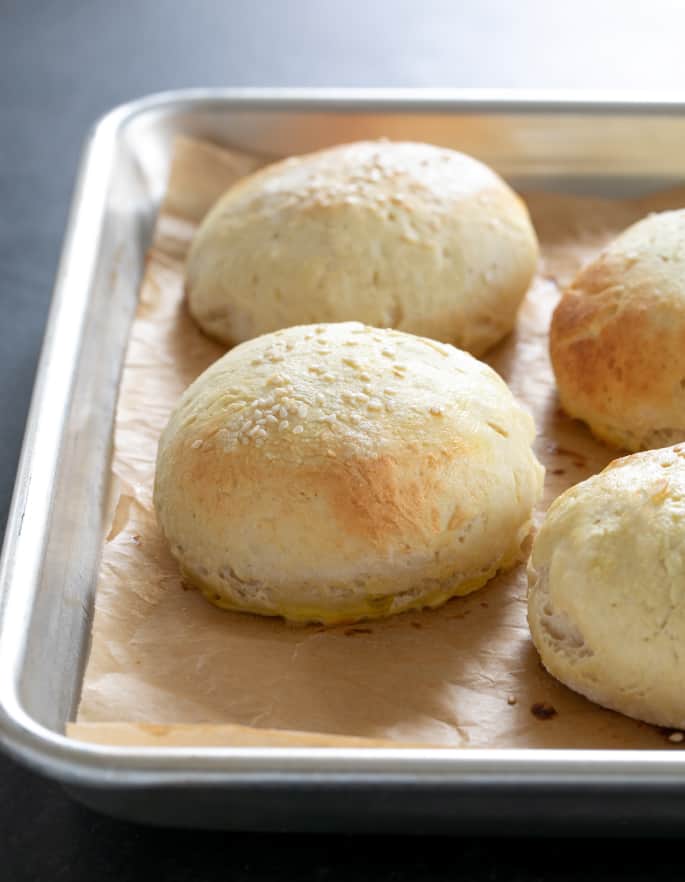
Gluten free buns: ingredients and substitution suggestions
Gluten free dairy free hamburger buns
In place of nonfat dry milk or buttermilk powder, you can use powdered coconut milk by weight (about 40 grams). In place of butter, Melt or Miyoko's Kitchen vegan butter should work great.
Gluten free egg free hamburger buns
There is one egg white in the bread dough, which helps them rise.
You can try replacing it with aquafaba (the brine from a can of chickpeas), but I'm afraid I haven't heard about great results from using that in baking.
The egg wash on top of the rolls can be replaced with melted butter or even some olive oil. It helps the rolls brown lightly in the oven, and take on a slightly shiny appearance.
Vegan, gluten free hamburger buns
You can make this easy gluten free hamburger bun recipe vegan by following my suggestions above for replacing the dairy and eggs. Just be sure your brown sugar is made without bone char.
Apple cider vinegar or cream of tartar replacements
Both apple cider vinegar and cream of tartar help add lightness and lift to these rolls. If you'd like to try eliminating one or both, you can try lemon juice in their place, but you'll have to experiment with amounts.
Expandex replacement
You absolutely do not have to use Expandex modified tapioca starch (which is not the same as regular tapioca starch) in place of some of the flour in this recipe.
It does help to make the dough easier to handle, and the rolls chewier. They also tend to have a longer shelf life. You can also try, in this individual instance, replacing the Expandex with regular tapioca starch/flour.
For a more complete discussion of what Expandex can add to a gluten free bread recipe like this, please see our recipe for basic gluten free pizza dough.
FAQs
If you buy gf burger buns at the store, they may or may not be wheat free. For example, gluten free bread made with Caputo Fioreglut gluten free flour is not wheat free, since that flour uses wheat starch as an ingredient.
Alternately, make your own wheat free bread when you follow my homemade gluten free hamburger buns recipe. Better Batter gluten free flour, the classic blend all purpose gluten free flour I recommend, is free of the top 8 allergens, including wheat.
No, this gluten free burger bun recipe won't work if you just grab a random gluten free flour from your pantry.
Making these buns with almond flour or coconut flour, for example, just won't produce the right taste or consistency — unless you're a fan of dense, crumbly, and oddly flavored hamburger buns?
When yeast bread dough doesn't rise, there are many possible causes. Did you use one of my recommended gluten free flour blends? Did you measure by weight, not volume? If not, you probably overmeasured your flour which will make the dough dry. Dry dough won't rise. Did you incorporate too much flour into the buns during shaping? That will also dry out the dough.
You could shape this recipe's dough into a hot dog bun, but I've got a better recipe you can try instead. My gluten free hot dog buns recipe produces a more pliable dough that's better for the unique shape of hot dogs and sausages.
The best way to tell if your gluten free hamburger rolls are done baking is to use an instant read thermometer. A finished bun will read 190°F in the center when done.
Shaping a homemade gluten free hamburger bun by hand is really simple: Just roll a piece of dough in your hand until it's round, and then flatten it into a disk by pressing it against a floured surface.
If you want to make gluten free sandwich buns, just flatten the disk a little more so that the dough is flatter. For gluten free slider buns, use less dough to make bite-sized buns.
Yes, you can use active dry yeast instead of instant yeast, but you'll need to use 25% more yeast, by weight (here, that would mean just over 11 grams active dry yeast), and you'll have to dissolve the yeast in some of the water in the recipe before adding it to the rest of the bread dough ingredients.
Gluten Free Hamburger Buns

Equipment
Ingredients
- 3 ¼ cups (455 g) all purpose gluten free flour blend, plus more for sprinkling (I used Better Batter; click thru for details) (See Recipe Notes)
- 1 ½ teaspoons xanthan gum, omit if your brand already contains it
- ½ cup (43 g) cultured buttermilk blend powder, (or 1/2 cup + 2 tablespoons (40 g) milk powder)
- 1 tablespoon (9 g) instant yeast, (or 1 1/2 tablespoons active dry yeast) (See Recipe Notes)
- ¼ teaspoon cream of tartar
- ¼ teaspoon baking soda
- 1 tablespoon (13 g) packed light brown sugar
- 1 teaspoon (6 g) kosher salt
- 1 teaspoon apple cider vinegar
- 2 tablespoons (28 g) unsalted butter, at room temperature
- 1 (25 g) egg white, at room temperature
- 1 ½ cups (12 fluid ounces) warm water, (about 95°F) (See Recipe Notes)
- Egg wash:, 1 egg of any size at room temperature, beaten with 1 tablespoon milk or water
- Sesame seeds for sprinkling, optional
Instructions
Make the bread dough.
- In the bowl of your stand mixer fitted with the paddle attachment, place the flour, xanthan gum, buttermilk powder, yeast, cream of tartar, baking soda, and brown sugar and whisk to combine well with a separate, handheld whisk. Add the salt, and whisk again.
- Add the cider vinegar, butter, egg white, and warm water, and mix on medium speed in your stand mixer until the dough begins to come together.
- Turn the mixer to high speed and beat until the dough is no longer a ball but has begun to appear whipped.
- Transfer the dough to an oiled container with a tight-fitting lid or a greased bowl, spray lightly with cooking oil spray, and cover tightly.
- Place in a warm, draft-free area to rise until it’s about 150% of its original volume (about an hour), or refrigerate the dough for up to 3 days.
Shape the buns.
- When you’re ready to make the rolls, line rimmed baking sheets with unbleached parchment paper.
- If you’ve refrigerated the dough, work with it straight from the refrigerator. If you haven’t, place the tightly sealed dough in the refrigerator to chill for at least 15 minutes before working with it, as the dough is easiest to handle when it’s chilled.
- Turn the dough out onto a flat, lightly floured surface, and sprinkle the top with additional flour. Work the dough, squeezing and kneading it, turning it over frequently, until it has begun to appear smoother.
- Using a bench scraper or large knife, divide the dough in two parts and set one half aside (cover to prevent its drying out). Working with the second half of dough, divide it again into 4 equal portions.
- Working with one piece of dough at a time, sprinkle it with more flour, form it into a ball by pinching the ends underneath, then rolling it with the side of your palm pressed against the surface and guiding it with your fingertips into a round.
- Sprinkle the dough with more flour and press it into a disk about 3/4-inch thick with your fingers and palm. Place the disk on one of the prepared baking sheets.
- Repeat with the remaining pieces of dough, and then eventually the other half. You’ll have 8 disks of dough.
Let the shaped buns rise.
- Cover the baking sheets with oiled plastic wrap and place in a warm, draft-free location until each piece of shaped dough is at least 150% of its original volume (about an hour).
- After about 45 minutes, preheat your oven to 400°F. Don’t allow the dough to rise any longer once the tops of the dough begin to take on a pock-marked appearance.
Bake the buns.
- Brush the tops and sides of the risen buns generously with the egg wash, and sprinkle with the optional sesame seeds.
- Place in the center of the preheated oven and bake until the rolls are puffed and the tops are very pale golden brown (about 18 minutes). The center of each roll should be about 190°F when tested with an instant-read thermometer.
- Remove the rolls from the oven and allow to cool on the baking sheet until no longer hot to the touch before slicing and serving.
- Any leftover rolls can be sliced, cooled completely, then wrapped tightly in a freezer-safe bag (remove as much air from the bag as possible).
- Freeze for up to 2 months. Defrost in a toaster set to light toasting.
Video
Notes
Nutrition
Nutrition information is automatically calculated, so should only be used as an approximation.


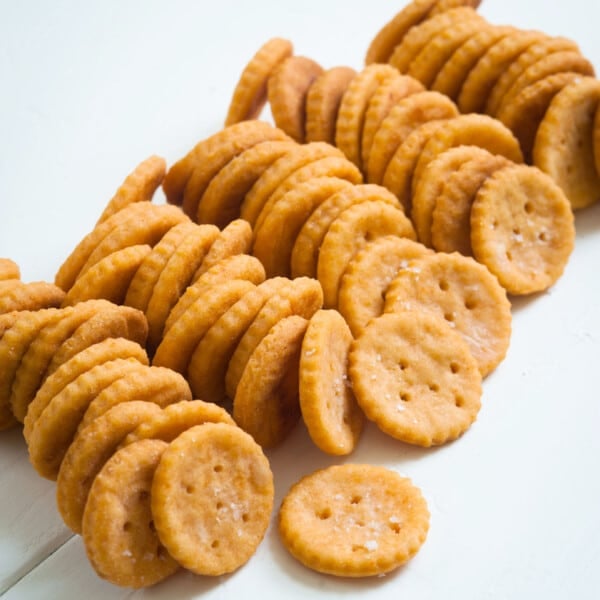


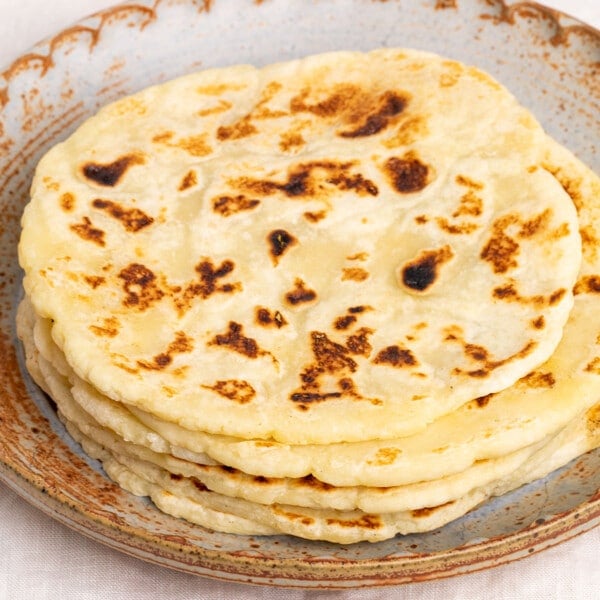









I made these once and omitted an ingredient by mistake… so I’ll be trying again…Question? Would the Japanese milk bread recipe work as a bun? Thanks!
I’m afraid I really don’t know if that recipe would work as a bun, Arlene, but typically I develop bun recipes to rise less, like this recipe, so they don’t lose their shape as they rise. I’d stick with this recipe, and make sure you use a proper all purpose gluten free flour blend (ideally, Better Batter here or my mock blend), measure by weight, and not make any substitutions.
My question is what should the initial consistency of the dough be before refrigeration?
Please post a picture or describe the consistence of the dough before rising.
I’ve described the consistency in the recipe by explaining that you are meant to beat it with the paddle attachment of a stand mixer until it begins to appear whipped in consistency, and there’s a video showing me making the dough, transferring it to the proofing bucket, and then removing it from the bucket and shaping it, Angeline. If you’re not seeing the video, you’re using an ad blocker and it’s only available to those who are willing to be served ads in exchange for the free recipes and other content.
Just to make sure I’m reading this correctly: if I want to refrigerate the dough, I never have to do a proper rise? Just mix, bowl, and refrigerate, with no rise in-between?
Correct, Alyssa. The first rise is a cold one. Then shape, rise, bake. Just as it’s written!
Hi,
I tried this recipe for the first time today. Following the instructions, and using your recipe for bread flour with Ultratex 3 the dough came together more like pancake batter rather than bread dough. It never formed a ball as referenced in step 3. I added enough extra flour to make it manageable, but rather than rise they spread out with only about 1/2 of the rise I would have expected. The resulting buns were tasty, although heavy and thinner than I had hoped. I did not want to add the extra flour, but it was unmanageable and I did not want to waste it. My question is what should the initial consistency of the dough be before refrigeration? And any ideas on were I may have gone wrong? I have made many recipes from your site and all are really good. This is the first problem i have had.
Thanks for all you do,
Scott
Scott, you can’t make this recipe with my gluten free bread flour blend. That blend is only appropriate when the recipe specifically calls for it. This isn’t that recipe, which calls for an all purpose gluten free flour blend, ideally Better Batter. You can add a bit of Expandex in place of a bit of the Better Batter if you follow the other instructions in the recipe notes, but in no case can you use my gf bread flour blend. Please reread the recipe, and the accompanying text, both of which discuss this.
Just fyi, your “Shape the buns” section says to preheat the oven in step 1 but I think that step is later on. Thanks for all your recipes! I’m trying these today. ❤️
Yes, you’re absolutely right, Jaimie! I’ve omitted that first reference to preheating the oven. Thank you for letting me know!
Well, it took me 24 hours to finally source potato flour from a UK supplier that is gluten free and doesn’t cost the earth. I’ve learned that most suppliers in the UK use the term potato flour, or potato starch, to describe potato starch ONLY. Some major sources would have you believe yellow potato flour doesn’t even exist. Of course, I needed the ‘yellow’ flour. So, for other UK readers who want to buy ‘yellow’ potato flour to build the Mock Better Batter Blend (and, subsequently, the Bread Flour Blend) then I found it on thespiceworks.co.uk.
After all that searching, PHEW! I can finally get down and dirty with these divine looking hamburger buns. When my ingredients arrive, of course.
Thanks Nicole! I’m looking forward to baking bread that isn’t the density of a breeze block! :-)
That’s great information, Wendy! Thank you for sharing it with everyone. The whole potato flour question does become something of an issue when you’re outside the U.S. and trying to build the mock Better Batter blend.
What can I replace the expandex tapioca flour ?
What can I replace the whey isolate powder?
Hi, Ruth,
Please see the discussion of Expandex in the post. There is no whey protein isolate in this recipe.
Do you have any recommendations for a stand mixer? I’ve always wanted one but there are so many to choose from and look complicated ?
Hi, Julie,
That’s a great question. I’ve only ever owned a KitchenAid stand mixer. If I didn’t use it professionally, I would be completely fine with the classic tilt-head 4.5 quart bowl KitchenAid stand mixer (which I had and used happily for many years). They generally cost over $300, but you can find them on sale from time to time if you shop around. Right now and for about another week, I see that mixer is on sale on macys.com for about $200. If you have other questions, just ask!
Your Burger Bun sounds great, but we are recently dairy free, and while I have a butter im a little stuck here…
any idea what would be a suitable substitute for the buttermilk powder?
Please see the ingredients and substitutions section, Dee.
Can you use buttermilk instead of the water & butter milk powder ?
thanks
Ironically, I actually don’t find that buttermilk powder + water and actual buttermilk are good substitutes for one another, Frank. If you can’t find buttermilk powder, I’d recommend using dry milk powder.